Ban Rak Thai: A charming Yunnanese village in Mae Hong Son
Ban Rak Thai (บ้านรักไทย) is a tiny town in Mae Hong Son province in northern Thailand, surrounded by mountains and still home to Chinese style and Yunnan traditions brought here by Chinese settlers.
Ban Rak Thai is a lakeside village close to the Myanmar border, famous for tea terraces and mountain scenery. The road narrows near the lake, and tour buses crowd the area by late morning, so arriving early gives the best experience. Afternoon temperatures fall quickly, so carrying a jacket is recommended. For confident uphill starts and safe engine braking on the way down, riders often choose our motorbike rental options for this journey.
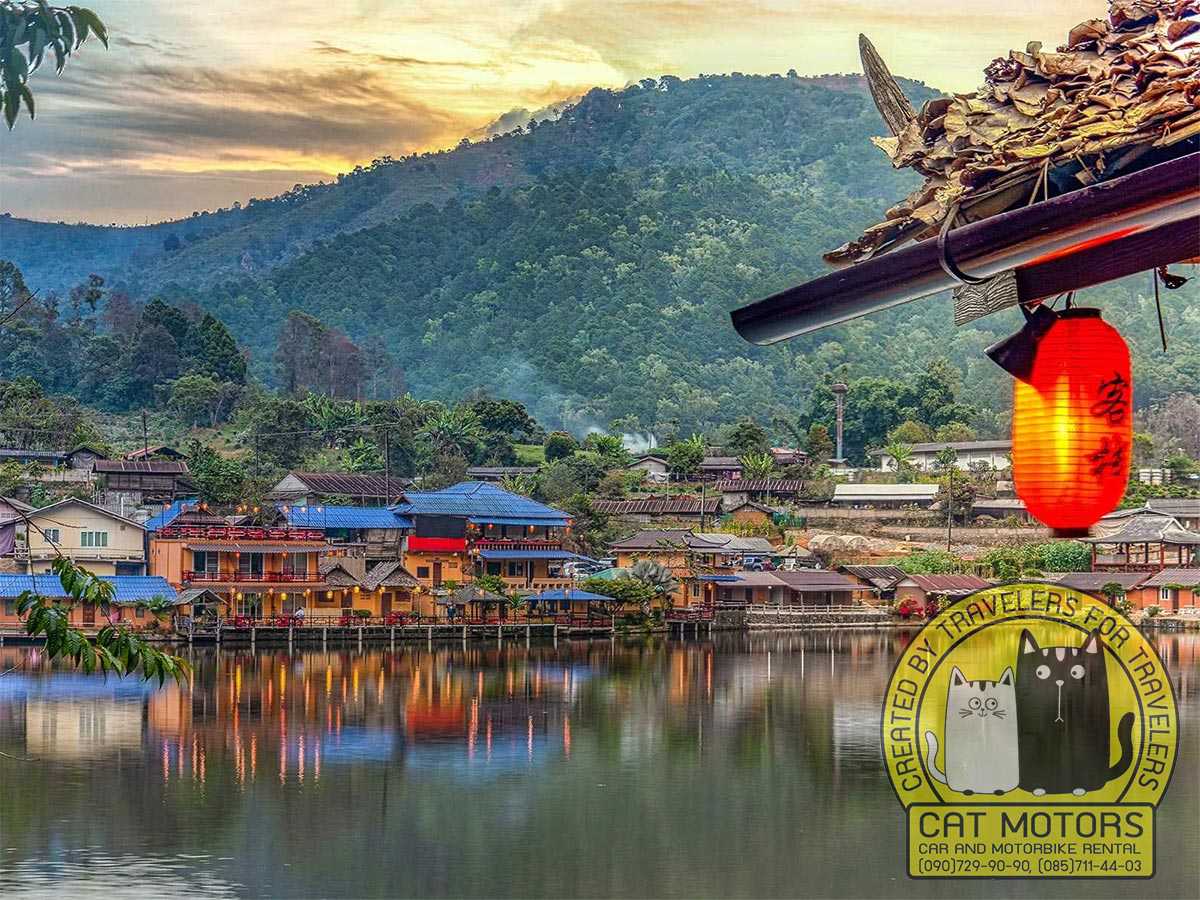
When we think of Thai winter tourist attractions, we imagine mist in the mountains, blooming flowers and a warm cup of tea. These factors combine to create a positive aura that makes us want to pack our bags and take a trip to travel through the thousands of twists and turns in the mountains to Ban Rak Thai.
History of Ban Rak Thai
In the rugged and untamed landscape, a tale of survival and resilience unfolds. Once a dense forest, the hills and mountains of this region served as a haven for a handful of Hmong hill tribe families, eking out a living amidst the wilderness. Opium cultivation, alongside crops of corn, rice, and vegetables, sustained these families, scattered across plots of land nestled in the foothills near Tok Mok Mountain, a towering peak that marked the natural border between Thailand and Myanmar.
The local mountains, which are the natural border between Myanmar and Thailand, in these places reach a height of 1865 meters above sea level, while the village of Ban Rak Thai is located at an altitude of 1180 meters above sea level.
But the history of Ban Rak Thai takes a dramatic turn, casting a shadow of war and upheaval. In the early 1960s, as battles raged between the National Army of Communist China and the National Army of Burma, a group of Chinese soldiers found themselves seeking political asylum in Thailand. These warriors, members of the 3rd Army under the command of General Li Wenfan, the 5th Army led by General Tuan Shiwen, and the 93rd Division, sought refuge in the towns of Fang and Mae Salong.
Yet, fate had more in store for these soldiers. In 1967, General Li Wenfan dispatched Commander Kung Chao Long with 180 soldiers from the 93rd Division to establish a strategic outpost along the border, a mere 6 kilometers from the site that would later become Ban Rak Thai. With their families in tow, these soldiers faced the daunting task of creating a semblance of civilization in the wilderness. They cleared the land, tilling the fertile soil to provide sustenance for the military and generate income by selling the bountiful vegetables they cultivated.
But their ingenuity didn’t stop there. These resourceful soldiers discovered another avenue for economic prosperity – collecting taxes at border checkpoints and providing protection for merchants and caravans traveling for trade between Thailand and Myanmar. This newfound role as guardians and intermediaries in cross-border commerce allowed them to earn a livelihood while establishing a foothold in the region.
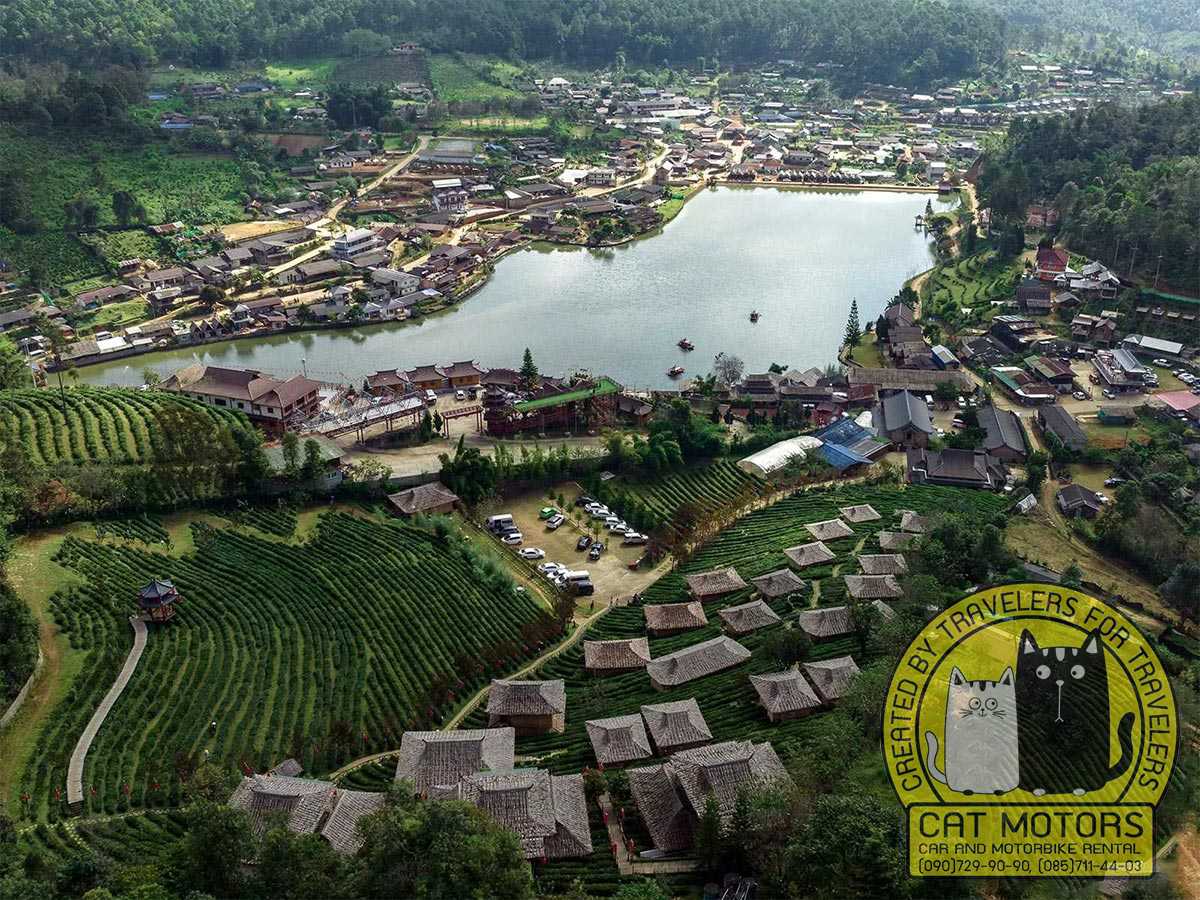
In the foothills and eastern reaches of the village, the Hmong hill tribe joined the efforts, cultivating opium amidst the fertile slopes. These resilient families, banding together, cultivated vegetable gardens at the base of the mountain, each plot a testament to their unity. In the subsequent years, additional Chinese military families from the 3rd and 5th Armies migrated to this nascent community. They constructed earthen houses topped with bamboo roofs, transforming the landscape into orchards, farms, and thriving vegetable gardens.
Time passed, and this patchwork settlement grew into a close-knit community. In honor of their profound gratitude towards King Rama 9 and the Kingdom of Thailand, which had offered them refuge and a second home, the village was christened Rak Thai, meaning “Lovers of Thailand.” The name symbolized the deep bond these inhabitants shared with their adopted land, their devotion etched into the very fabric of their existence.
In this rugged terrain, where the echoes of conflict once reverberated, a new chapter had unfolded. Ban Rak Thai stood as a testament to the indomitable spirit of those who, against all odds, had carved out a place to call home amidst the trials of war and the wilderness. Their entrepreneurial spirit, combined with the richness of the land, allowed them to not only sustain themselves but also thrive in this remote corner of the world.
Location And Accessibility
Located in the remote province of Mae Hong Son, Ban Rak Thai is a picturesque village in northernmost Thailand. This charming hamlet is situated 1,180 meters above sea level and offers a tranquil escape from bustling city life. Although reaching the Chinese village requires some effort due to its remote location, the journey is well worth it.
You can get to the village by taxi, car, songthaew or motorbike. When you get here, you can walk around the village. For a more immersive experience, consider joining a guided tour to explore the hidden corners of this village.
And while exploring the village, consider venturing to the nearby Mae Hong Son Town (Google Map), adding an extra layer of discovery to your journey.
Ban Rak Thai may be small, but it boasts a wealth of enchanting attractions that can be discovered leisurely. Renting a car allows you to embark on a scenic round trip, with opportunities to visit nearby points of interest.
Alternatively, songthaews, local shared taxis, operate daily and offer transportation to the village. You can hop on these vehicles in Chiang Mai, Mae Hong Son, or Pai. That said, it’s best to start your day early to secure a seat – since they tend to fill up quickly. Keep in mind that waking up too late may cause you to miss the departure.
To make the most of your visit, plan your trip from mid-December to mid-January or February to March when the weather is most comfortable. If you’re not a fan of scorching weather, avoid visiting from April to June, as these months are the hottest. Instead, embrace the refreshing winters, offering respite from the humid Thai climate and an ideal backdrop for your exploration.
Things To Do At Ban Rak Thai
Ban Rak Thai is a place that you visit to relax and connect with nature. This hidden village is an experience for your soul, and while there aren’t many attractions here, it’s the perfect place to end your tour of Thailand and take in the magic of this hidden village. With that in mind, some of the things you can do in the village include:
Embark On A Memorable Boat Ride Voyage
The highlight of a visit to Ban Rak Thai is an immersion in Thai-Chinese culture that blends together in an amazing way. The atmosphere of Ban Rak Thai transports us to provincial China and allows us to imagine ourselves in scenes of Chinese movies.
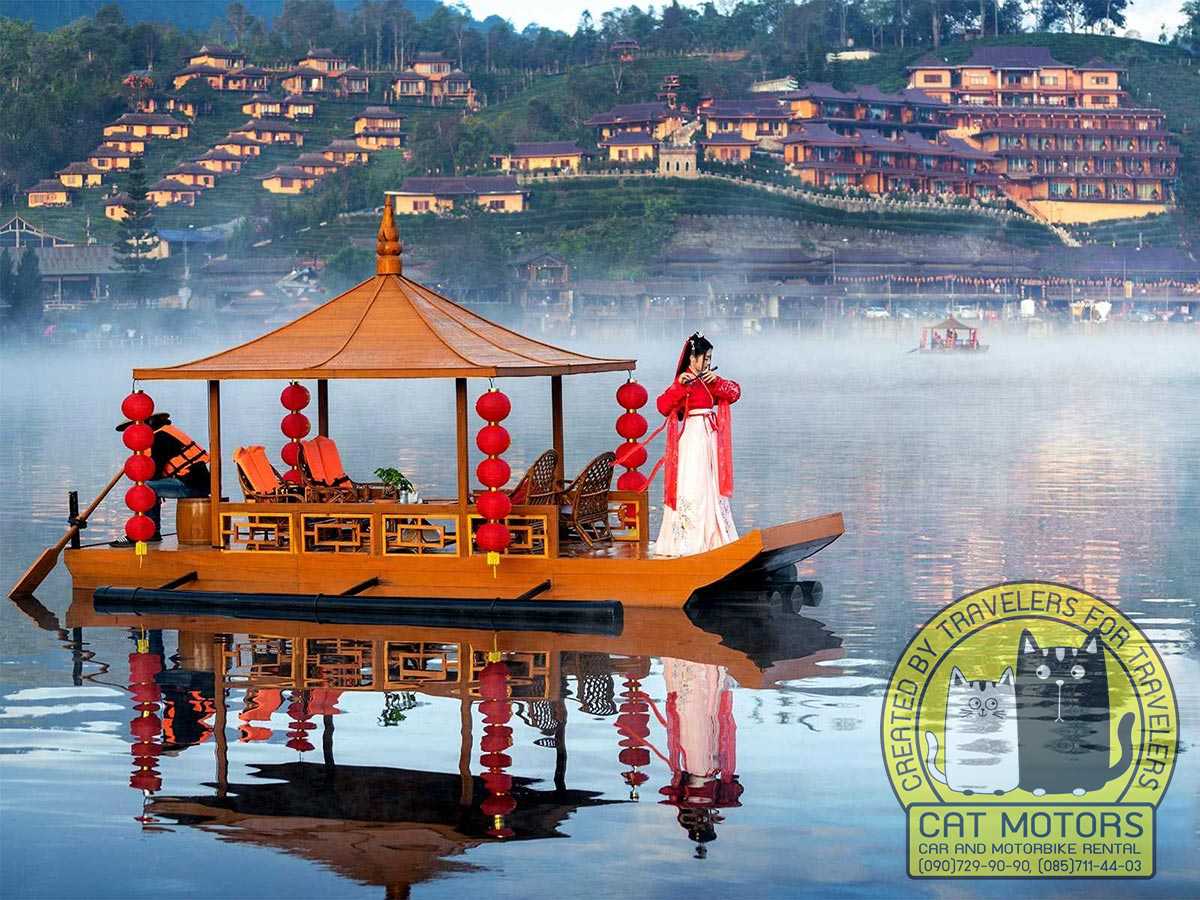
Step into a world reminiscent of ancient Thai Chinese-style charm as you set foot on these resplendent boats adorned with vibrant red lanterns. Nestled within this secluded village lies a captivating lake where the allure of serenity beckons. While the village itself may offer limited diversions, an enchanting journey across the tranquil waters aboard a traditional vessel promises an unforgettable day.

Immerse yourself in the ambiance of distant lands, transporting your senses to the heart of China. Departing from the renowned Lee Wine Cafe (Google Map) starting at 7:30 in the morning, these boats gracefully glide throughout the day, affording you some Instagram-worthy views of the village, especially during the peaceful dawn hours.
Tea Tasting: Taste A Blend Of The Thai China Culture
The tea products of Ban Rak Thai are widely recognized. Because of the hilly landscape and the cold temperature due to the sea level of 1,776 meters, the area is very suitable for tea cultivation. In addition, traditional Chinese steamed Mantou buns are very popular among Thais and are worth tasting.
Follow your nose to bountiful tea plantations that will introduce a world of exciting flavors and aromatic brews. Delighting both the locals, who earn their livelihood from these plantations, and the influx of visitors who arrive during the vibrant Chinese New Year festivities in February, Ban Rak Thai offers a captivating tea-tasting festival.
This celebration honors the artistry of producing exquisite green teas, amongst various tea cultivation, and captivates guests with live performances and authentic local entertainment.
Along the scenic lakefront of the village, an array of enchanting restaurants and charming tea houses await, each boasting a panoramic vista of the shimmering waters. Indulge in the warm embrace of a fragrant cup of tea sourced from various dried fruits while immersing yourself in the awe-inspiring views of the serene lake and its natural splendor.
Witness Ban Rak Thai First-Hand: Exploring The Village
When visiting this mystical place, you can walk through the village and admire the ancient Chinese influence. You’ll be greeted with bright red lanterns, little eateries, cafes, and many tea houses, which the village is famous for.
One of the best places to stop for a cup of tea is Lee Wine Coffee (Google Maps); it’s got one of the most amazing views of the lake and is decorated with traditional Chinese architecture.
Many tourists also stroll through the cherry blossom walkway (as part of the “Thai Sakura” scene) and visit the village for a bowl of noodles or fried rice!
There are also many other activities such as hiking, biking, boating, and horseback riding to the Myanmar border. And the picturesque scenery would be a good idea to fill your Instagram.
Nearby Attractions
Ban Rak Thai may be the highlight of your trip to Thailand, but a few nearby attractions make interesting stops while traveling through this part of Thailand. Many of these attractions can be visited before or after your trip to the village and are mainly found in the Mae Hong Son province.
Phu Klon Country Club Mud Spa
Phu Klon Mud Spa is a unique spa offering mud treatments that rejuvenate your skin. The mud used isn’t just any mud sourced from a nearby spring, known for its rejuvenating and healing properties. If you’re in need of self-care or want to try a unique mud treatment, this is a great place to stop on your way to Ban Rak Thai.
Wat Phra That Doi Kong Mu
Wat Phra That Doi Kong Mu is a Burmese temple founded in 1860 and houses the relics of a monk called Phra Maha Mok Kallana Thera. This exquisite White Temple is a great place to visit; buy a few souvenirs and enjoy views of Mae Hong Song from the temple’s coffee shop.
Pang Oung
Not too far from the village of Ban Rak Thai is Pang Oung, a resource and wooded area with a lake and mountain ranges. There are a couple of accommodation options close to the lake, but the real beauty can be experienced by camping here.
Pang Oung is a great place to jog, picnic, and enjoy the natural surroundings. This reservoir is also called ‘Switzerland in Thailand’ due to its resemblance to the landscapes found in Switzerland.
Kaew Komol Cave
The Kaew Komol Cave stands as an awe-inspiring testament to the marvels of nature. Renowned as one of Thailand’s most extraordinary caves, its crystal calcite formations are unrivaled in their splendor. Since opening its doors to visitors in 1995, this hidden gem has mesmerized explorers with its ethereal beauty.
Immerse yourself in a 20-minute journey of wonder as you traverse this subterranean realm. Venture deep into the heart of the cavernous chambers, where you’ll encounter a tapestry of five magnificent halls adorned with glistening calcite crystals. Be prepared to be captivated by their sheer purity and exquisite allure.
The cave’s entrance fee grants you access and includes a delightful songthaew ride leading you to the gateway of this natural treasure.
Mae Hong Son Town
Around 43km (26 miles) south of Ban Rak Thai lies Mae Hong Son Town (Google Map). Comprised of luxuriant mountains and forests, this charming town with a mere 7,000 residents offers a serene escape from urban chaos. Infused with a captivating Burmese influence, Mae Hong Son Town unveils its unique architecture, culture, and cuisine.
Delight in the enchanting sight of illuminated temples like Wat Jong Kham (Google Map) and Wat Jong Klang (Google Map), their grandeur mirrored on the tranquil Jong Kham Lake. Meander through quiet streets, explore local markets, and savor Shan specialties like khao soi (noodle soup), and kaeng hang le (pork curry).
Beyond its cultural riches, Mae Hong Son Town serves as an ideal gateway to the region’s natural wonders. Explore various scenic road trips, winding through rice fields, cascading waterfalls, rejuvenating hot springs, and mysterious caves. And for the adventurous, immersive trekking tours lead you through dense jungles, where encounters with ethnic minority villages await.
While the Long-Neck Karen villages are renowned attractions, it’s important to conduct prior research to navigate the ethical considerations. Mae Hong Son Town beckons travelers who seek authenticity, diversity, and a genuine connection with nature—an opportunity to experience Thailand beyond the clichés, away from the crowds.
Ban Huai Makhuea Som
Ban Huai Makhuea Som (tomato village) is a village that is a 20-minute drive from Ban Rak Thai village. In the center of this village is a towering temple called Wat Ban Huai Makhuea Som, and it’s the first thing you’ll notice when entering the village. This temple is the main attraction in the town and is a great place to take a few photos and admire the architecture and design of the village temple.
Su Thong Pae Bridge
Su Thong Pae Bamboo Bridge is a bamboo bridge that is over 500 meters / 547 yards long and runs across the Mae Sa Nga River and rice field, linking the Kung Mai Saak village and the temple. This incredible piece of infrastructure is used daily by locals and monks, and the locals in the village constructed the entire bridge.
Although the bridge isn’t very high, the trek across it is something to behold, and you can follow it all the way through the winding valley and rice fields, admiring the natural wonder surrounding it. The best way to travel to the bridge is by scooter, as there is no public transport traveling to the bridge.
Every morning around 6 am, the offerings to the monks take place on the bridge, and this is the ideal time to immerse yourself in this experience and capture a few images of the bridge as the sun comes up.
All of the above attractions, and many more, including the village of Ban Rak Thai, you can explore on a self-guided tour of the Mae Hong Son Loop.
Where To Stay In Ban Rak Thai?
Lee Wine Rak Thai
Lee Wine Rak Thai, a famous clay resort in Baan Rak Thai, is surrounded by tea plantations in the hills with beautiful views. It is also incredibly close to another popular spot, Pang Ung, which is perfect for those who want to stay at Baan Rak Thai and see the misty sea in Pang Ung at sunrise. Lee Win Rak Thai stands on steep hills, getting there can be a bit tricky, but you won’t regret the stunning views if you decide to visit this place.
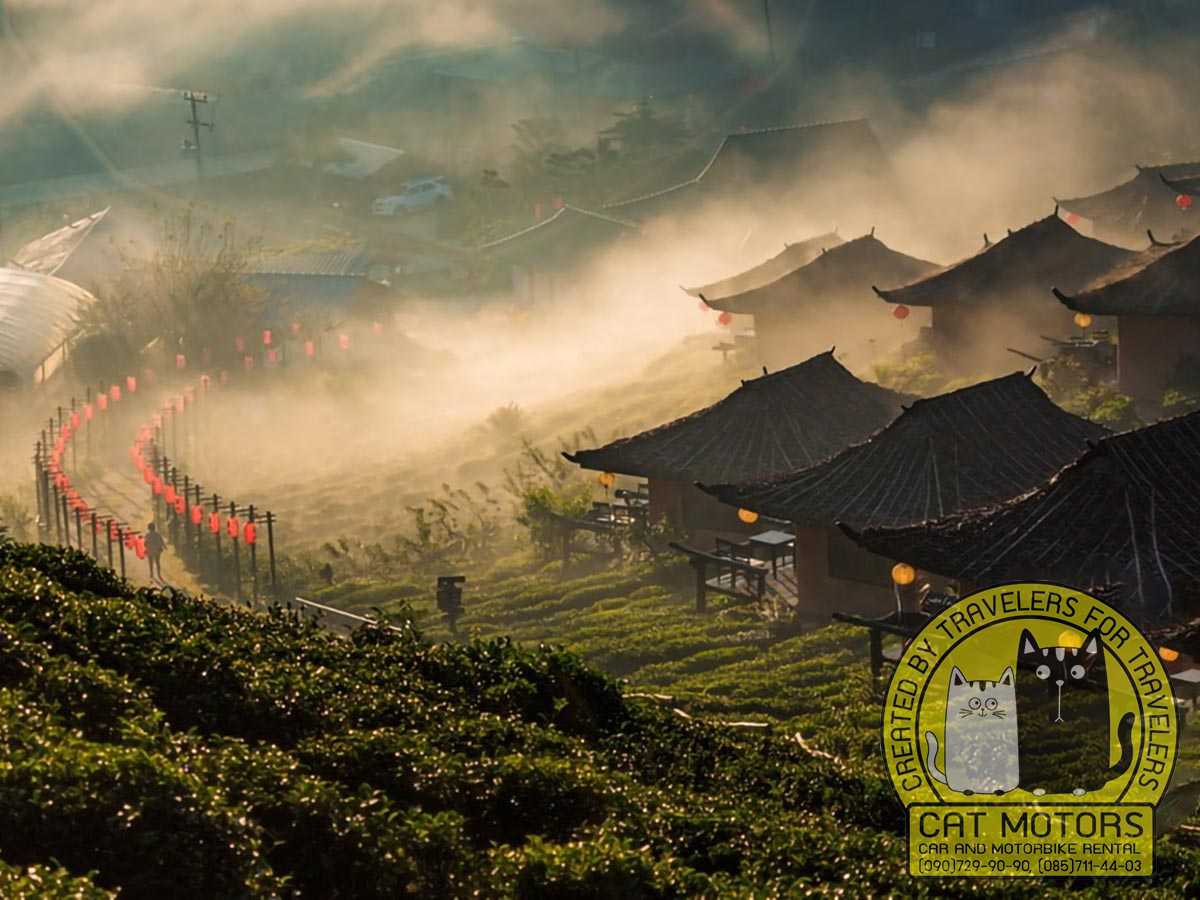
It is worth noting that Baan Rak Thai is also famous for its local beverages, including mulberry, peach, and gooseberry wines. Additionally, the place is renowned for its green tea, oolong tea, and dried fruits.
The weather is very comfortable during the day and can be very cold at night. But for the sake of Thai winter, it is worth getting into the atmosphere of the area, surrounded by fragrant tea plantations.
Other places to stay
In this area, the situation is the same as everywhere else in Thailand. The vast majority of guesthouse owners are not represented in any way or anywhere, so you can’t find them on any booking platforms. However, consider the following guest houses if you want to sleep in Ban Rak Thai modestly and without any frills.
Maan Mok Rak Thai (ม่านหมอก รักไทย)
This is a good quality accommodation, affordable, overlooking the river, where you can see the residential part of the Chasa Resort and Lee Wine Rak Thai. Check the location on Google maps.
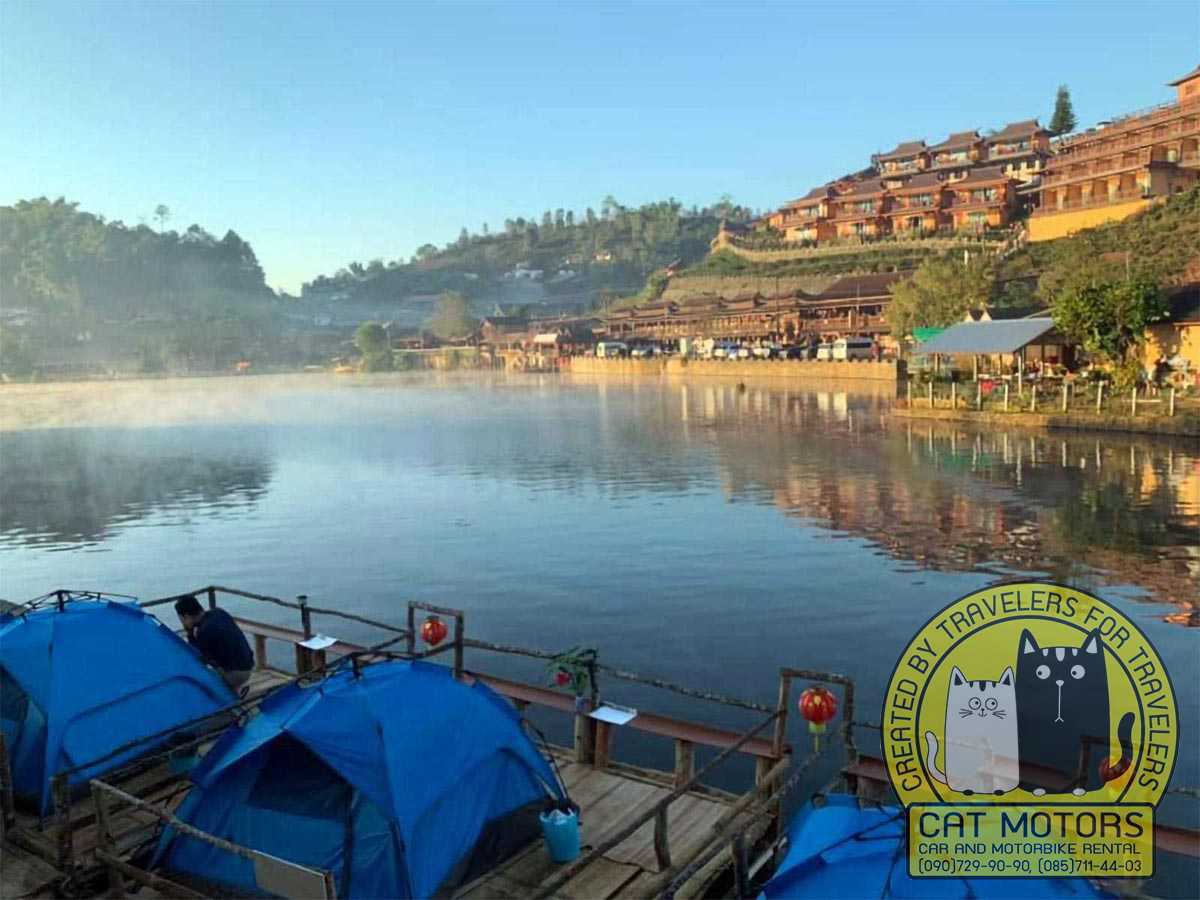
You can book a room with a fan or air conditioning, or stay in tents. Reservations are made through the Facebook page. When booking, transfer half the amount, upon check-in, pay the rest.
Inside the rooms, wide beds with soft mattresses, warm blankets, a dressing table and a hair dryer. In a separate bathroom you will find soap, shampoo and shoes to wear in the bathroom. The rooms have hangers, shelves for clothes, a sofa, slippers for walking in the room. For breakfast, you will be served Yunnan fried noodles. Here you will also find unlimited toast and hot tea, because this village is famous for tea.
Fried noodles are served around 07.30 in the morning. If you would like to check out early to continue your journey, please let the host know so that they can serve your breakfast earlier than usual.
Ping Ping Guest House
Another guesthouse located on the shore of the lake with stunning views of the surrounding area. Good value for money, even though some guests complain about poor soundproofing. The friendly hostess will always treat you to free tea or snacks, or cook Yunnan cuisine for a small cost.
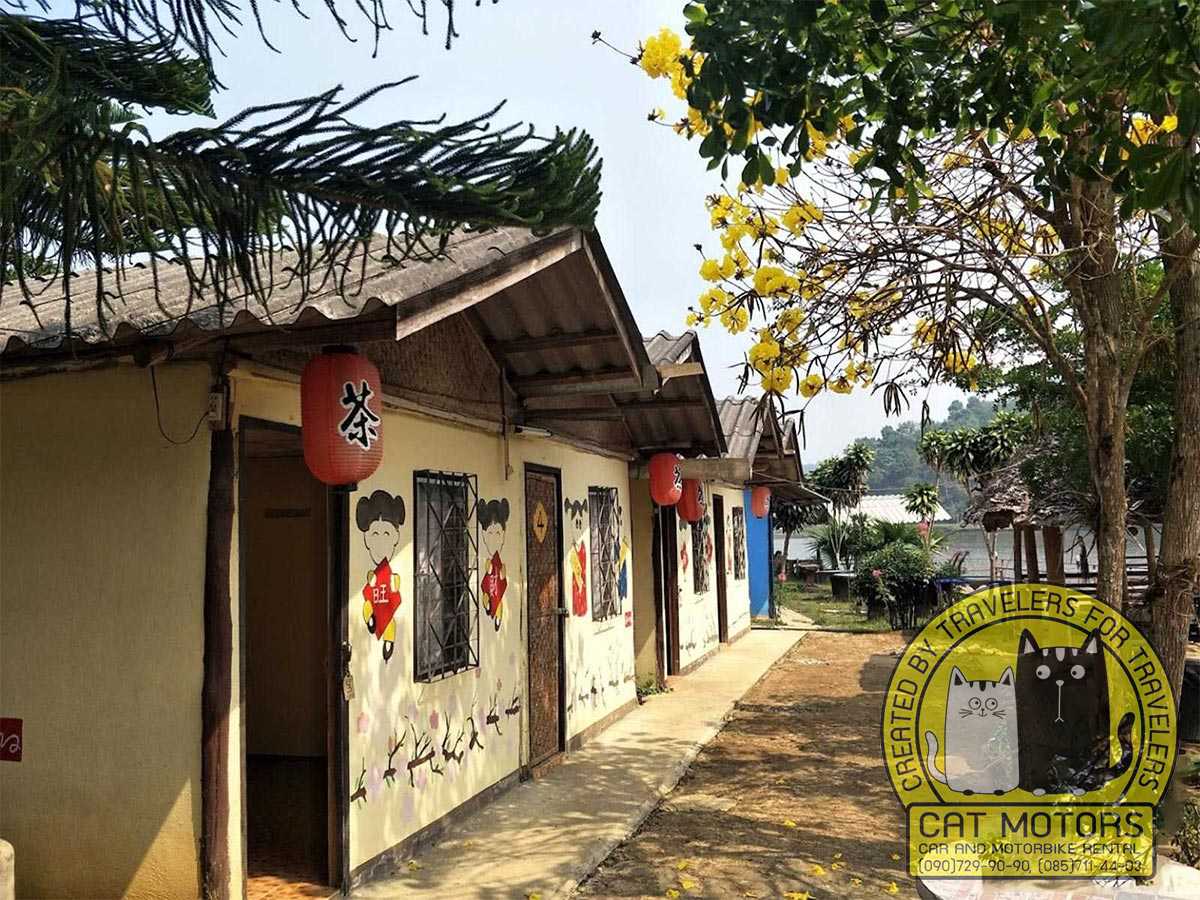
The only inconvenience tourists may experience is that the hostess does not speak English and the English-speaking staff is not always on site. Nevertheless, the accommodation fee overrides any possible disadvantages, as rooms even in high season are available for only 400 baht per night.
Yunnan Rak Thai Resort (ยูนานรักไทยรีสอร์ต)
Large rooms, large bathroom with good water pressure, hot water, clean towels, fast wi-fi (200Mb/s), a small terrace with a table overlooking the lake – what else does a tired traveler need?
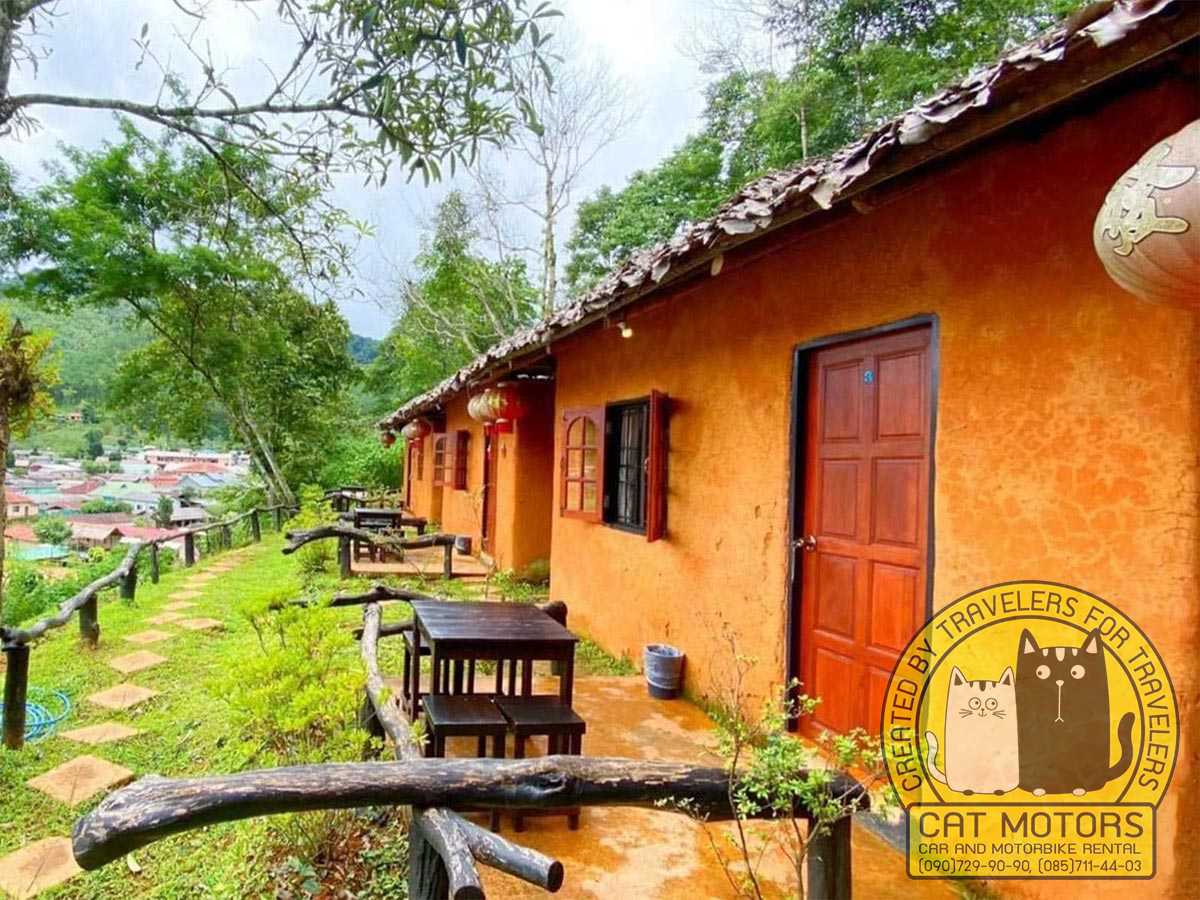
FB for room reservations + Google Map location
Despite the fact that the outside of the house is earthen, the interior has a nice and neat finish. You will not need air conditioning here as it is always cool.
Sala Rim Naam Campground
Camping located on the shore of the lake. The cost is 150-200 baht per tent. In the morning you will find a very wonderful atmosphere here, enjoying the view of the lake covered with thick mist. Nearby are many cafes and stores, which is very convenient for travelers.
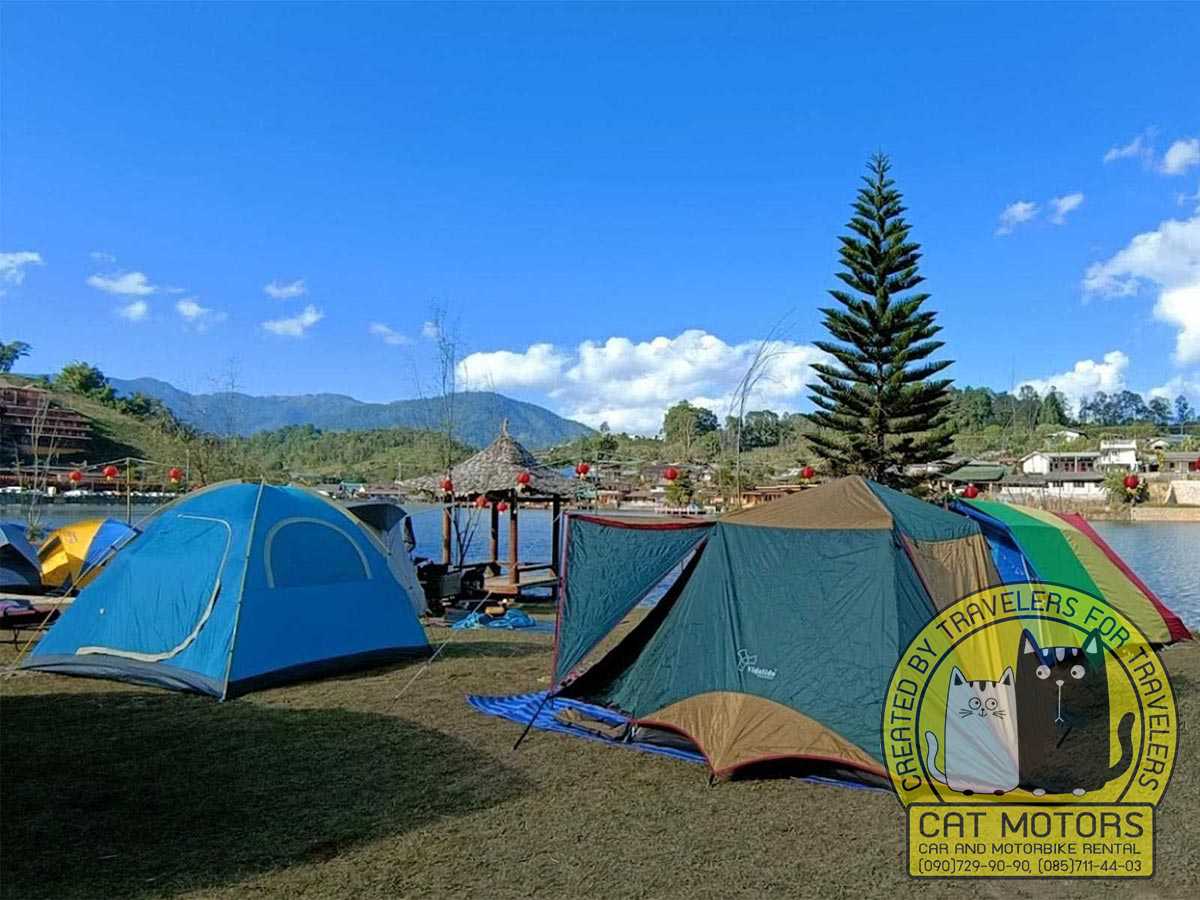
Note that there is no hot water and there are stray dogs running around. But the main disadvantage is that there are no reservations. If you want to stay here, you first have to go to Ban Rak Thai, come to the campsite, and only then will you find out if there are any spots available. Nevertheless, we recommend this place. An overnight stay in a lakeside tent is always unusual, relaxing and reassuring at the same time.
Where to eat in Ban Rak Thai?
Aunty Nuay’s Noodle Shop
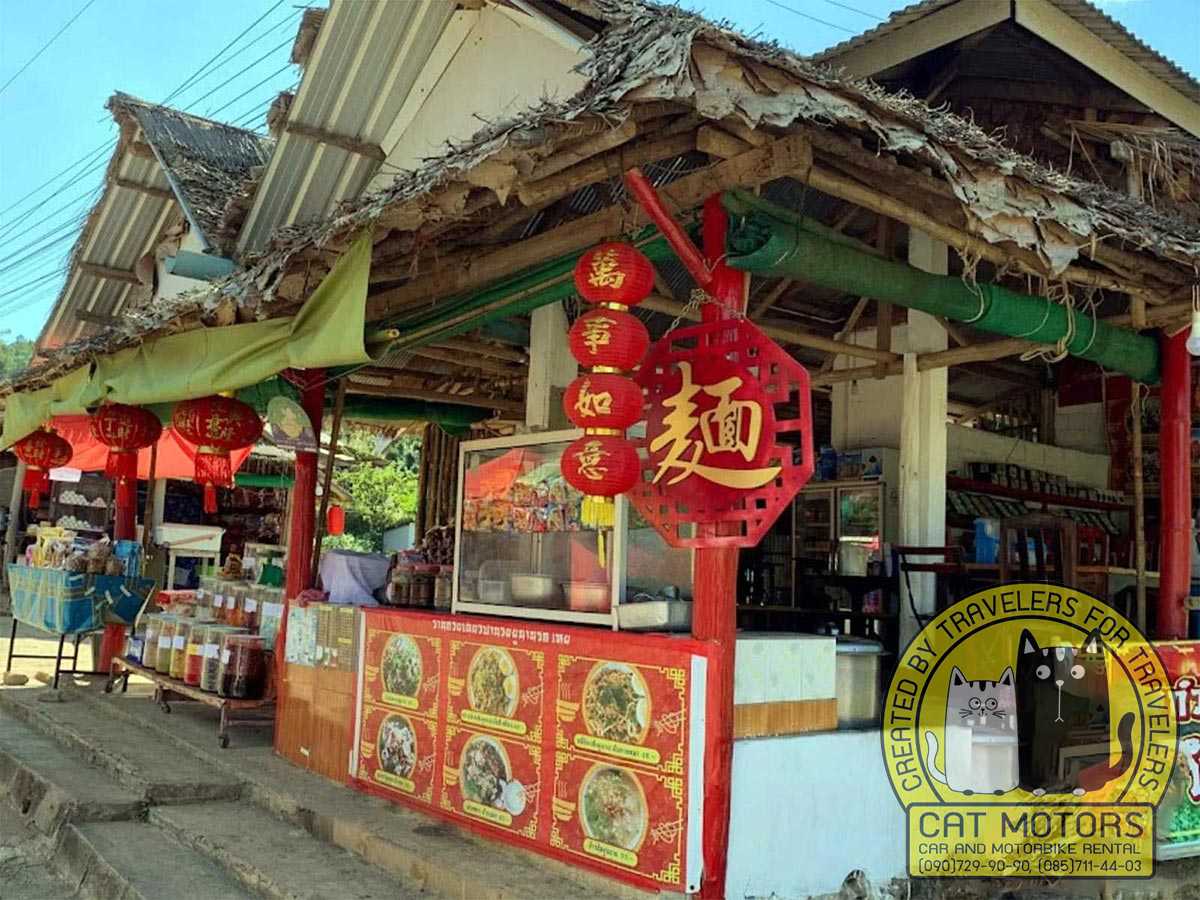
Nice little family owned Yunnan restaurant (Google Map) with a very friendly owner. On the menu you will find both traditional and vegetarian dishes. Here you can also taste the local tea and, if you like it, buy it. The price of food starts at 40 baht. The staff speaks English.
Li Xian Cafe
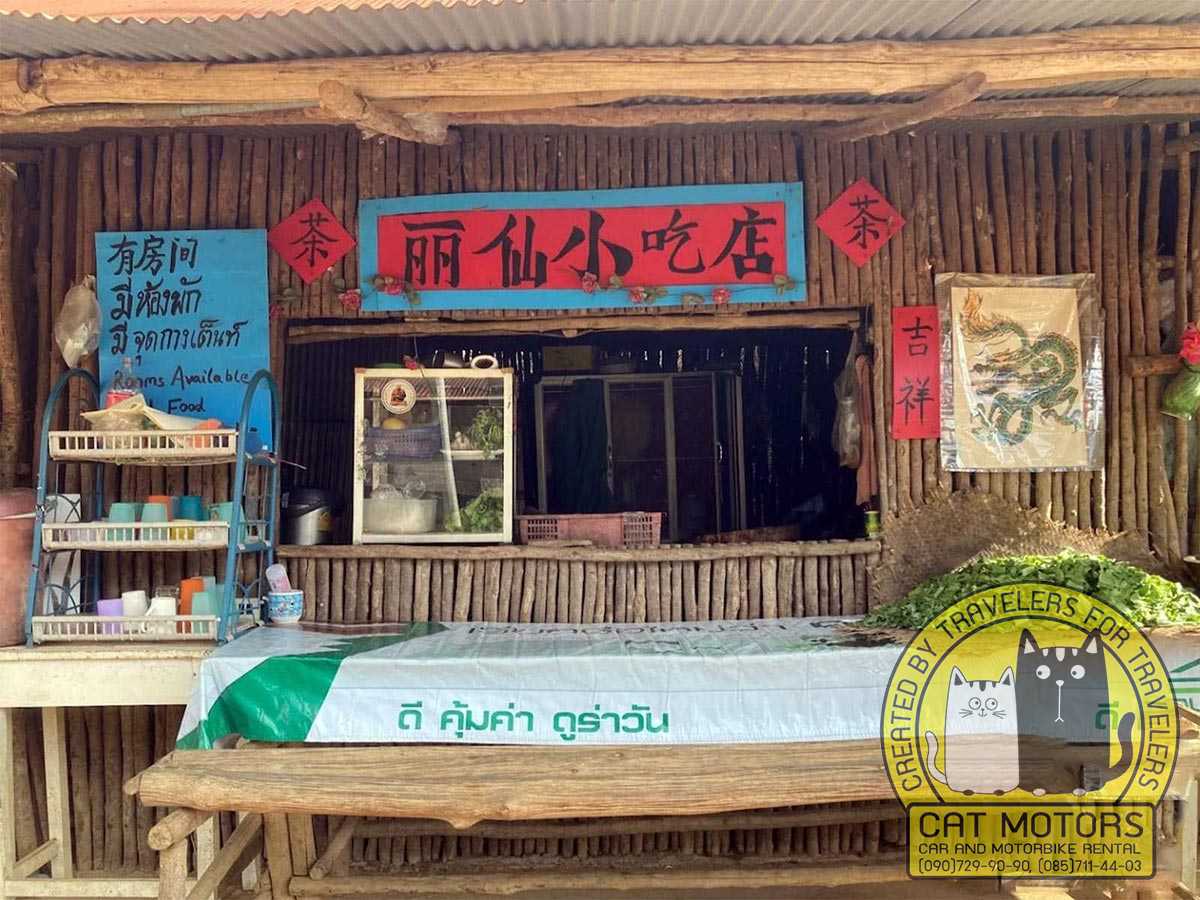
On the outside it looks very simple and unpretentious, but this meal will blow your mind! Try the salad with fresh green tea leaves or the pork noodle soup. The owner of the restaurant (Google Map) is very friendly.
Jee Lee cafe
In this cafe (Google Map) you will find a traditional Chinese meat and vegetable soup that you can cook yourself. The cost of the set is only 800 baht per pot, which will be enough to feed 4-5 people. Here you will also find the famous steamed Chinese buns.
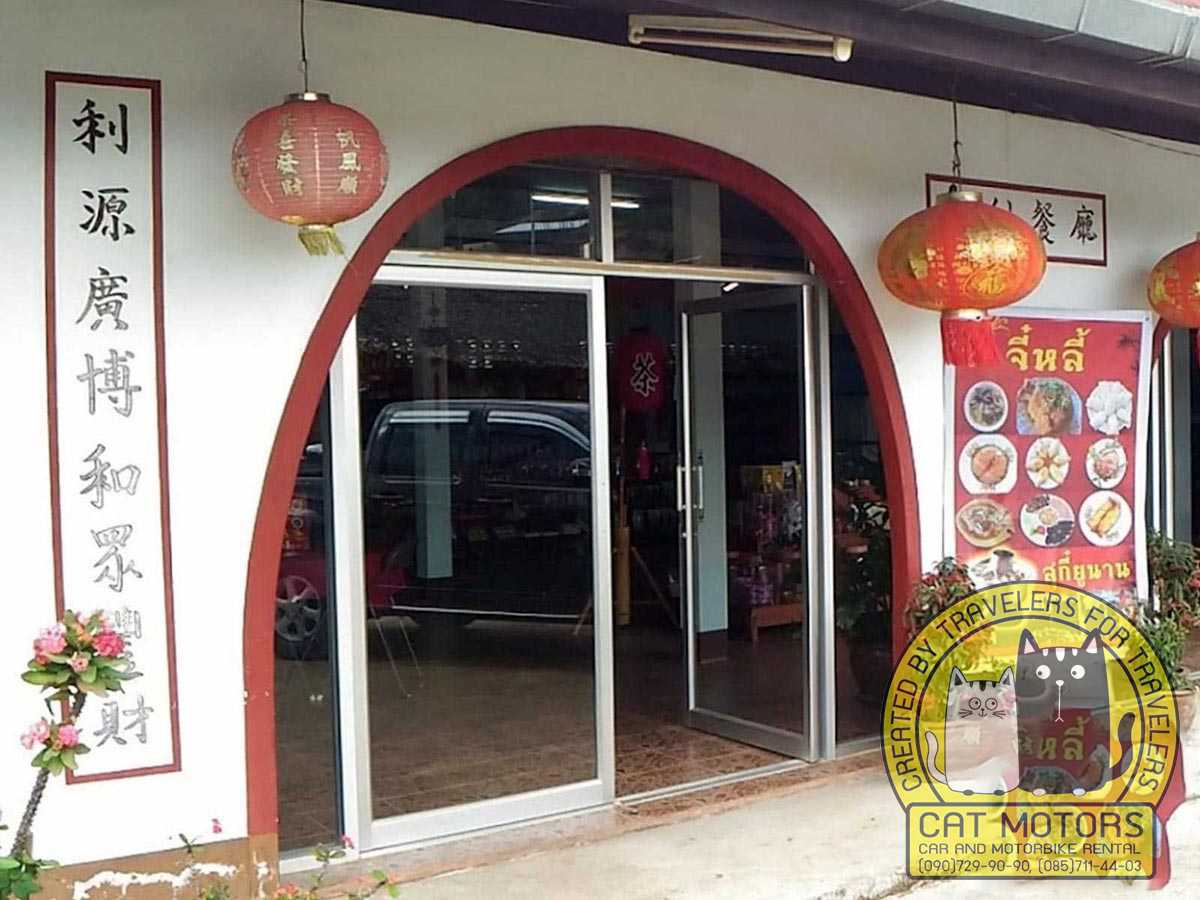
The pot is filled with water or broth, and when the water comes to a boil, chopped vegetables, pieces of meat and other products are poured into the pot – and soon it all becomes a delicious soup.
As the diners eat, broth is added to the pot and more food is added, so that the hot meal doesn’t run out as long as the meal lasts.
Khao Soi Yunnan
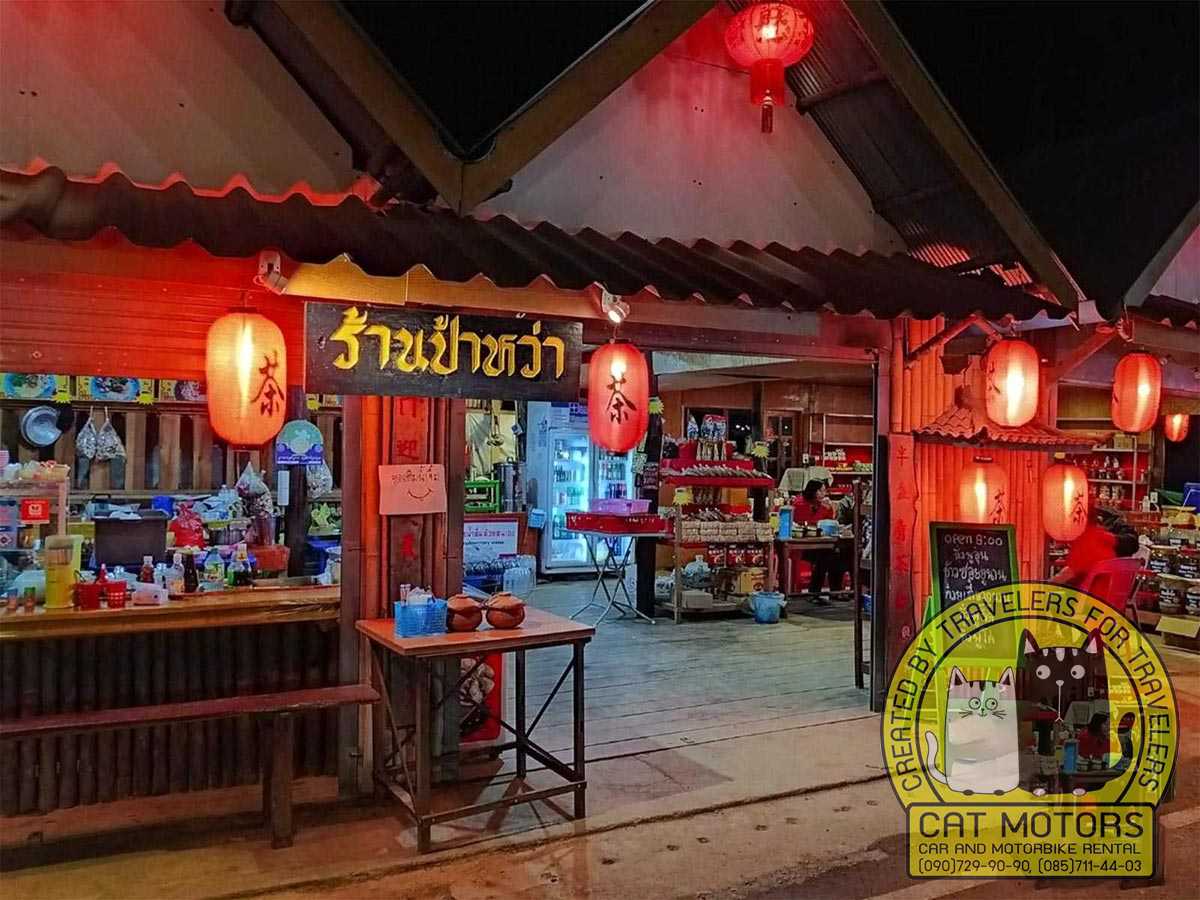
As the name suggests, this cafe (Google Map) specializes in making Khao Soi, which was named the world’s most delicious dish in 2022.
However, in addition to Khao Soi, you’ll find noodles, meatball soups, salads, coffee, and even shrimp crackers. And the view of the lake during your meal will give you additional pleasure.
Tips for Visiting
If you’re visiting this hidden village, there are a few things to remember to make the most of your trip or holiday and enjoy this hidden village.
- Avoid visiting Ban Rak Thai during the peak of summer, as temperatures are soaring, and there’s a lot of humidity.
- This village offers a serene escape, perfect for those seeking a tranquil retreat. However, if you’re looking for a wider range of activities, you might consider staying in Mae Hong Son Town (the capital), where you can immerse yourself in even more local attractions of this province.
- You can visit the Lee Wine Ruk Thai Resort and the plantations surrounding it for free, even if you aren’t staying there.
- Carry enough cash, there may be an ATM, but it’s best to have cash on hand just in case.
- This village has a few small stores offering the basics, but purchasing everything you need before traveling to Ban Rak Thai is better.
- Avoid visiting during the rainy season, usually from May to October.
- The weather is much cooler than in other parts of Thailand, so pack a few warm items to wear, especially if you’re visiting during winter.
- Make sure you make a booking in advance if you want to stay at Lee Wine Ruk Thai; it’s very popular and gets fully booked.
- When in Ban Rak Thai, make sure you take a boat trip to the lake and visit all the other attractions. The village is such a unique stop, and the journey isn’t worthwhile unless you explore the whole town.
Weather & Climate
Best Time To Visit Baan Rak Thai
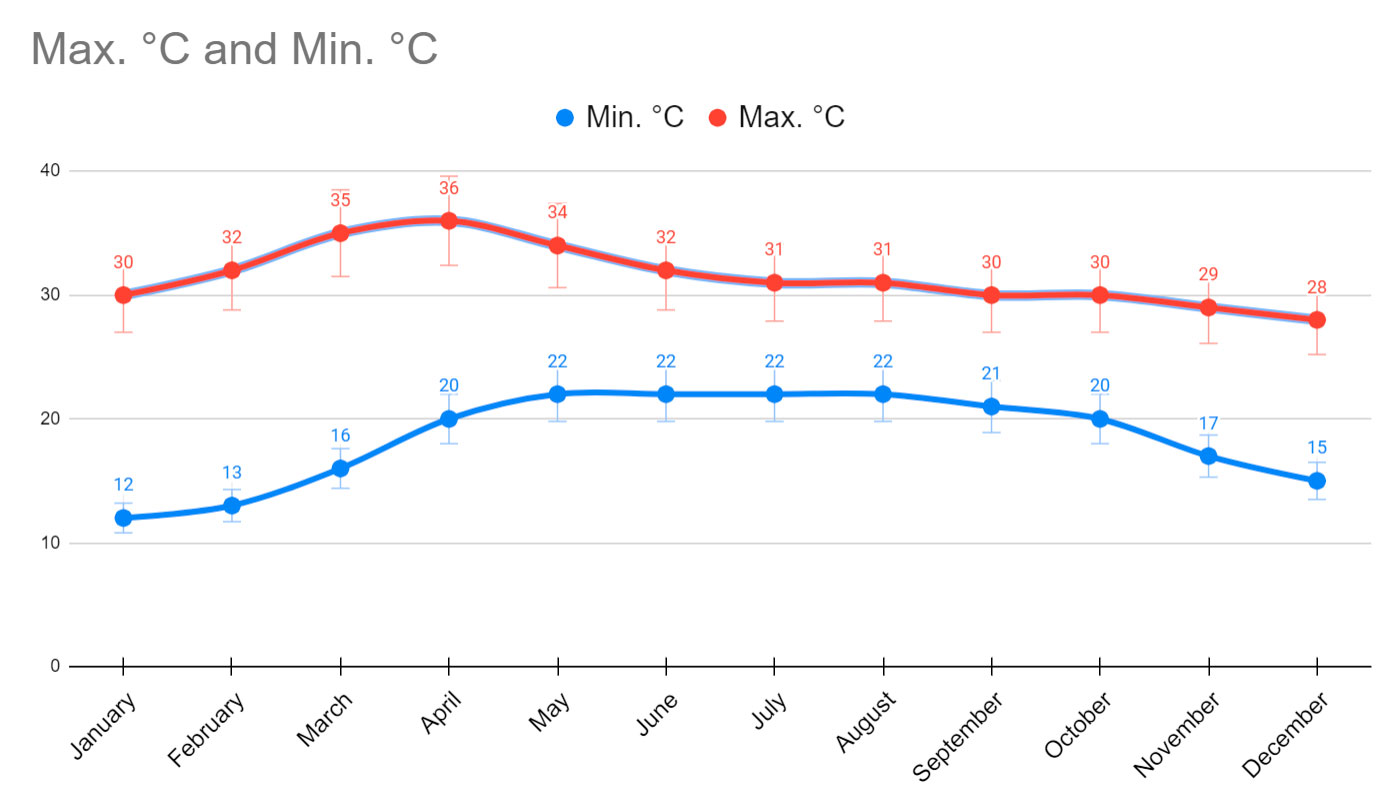
Although you can visit this Yunnanese village all year round, the best time to visit is November-February. During this time, the temperature drops to 30℃ during the day and 9℃ at night, the rainy season is over and the smoky season has not yet begun.
Rainy Season
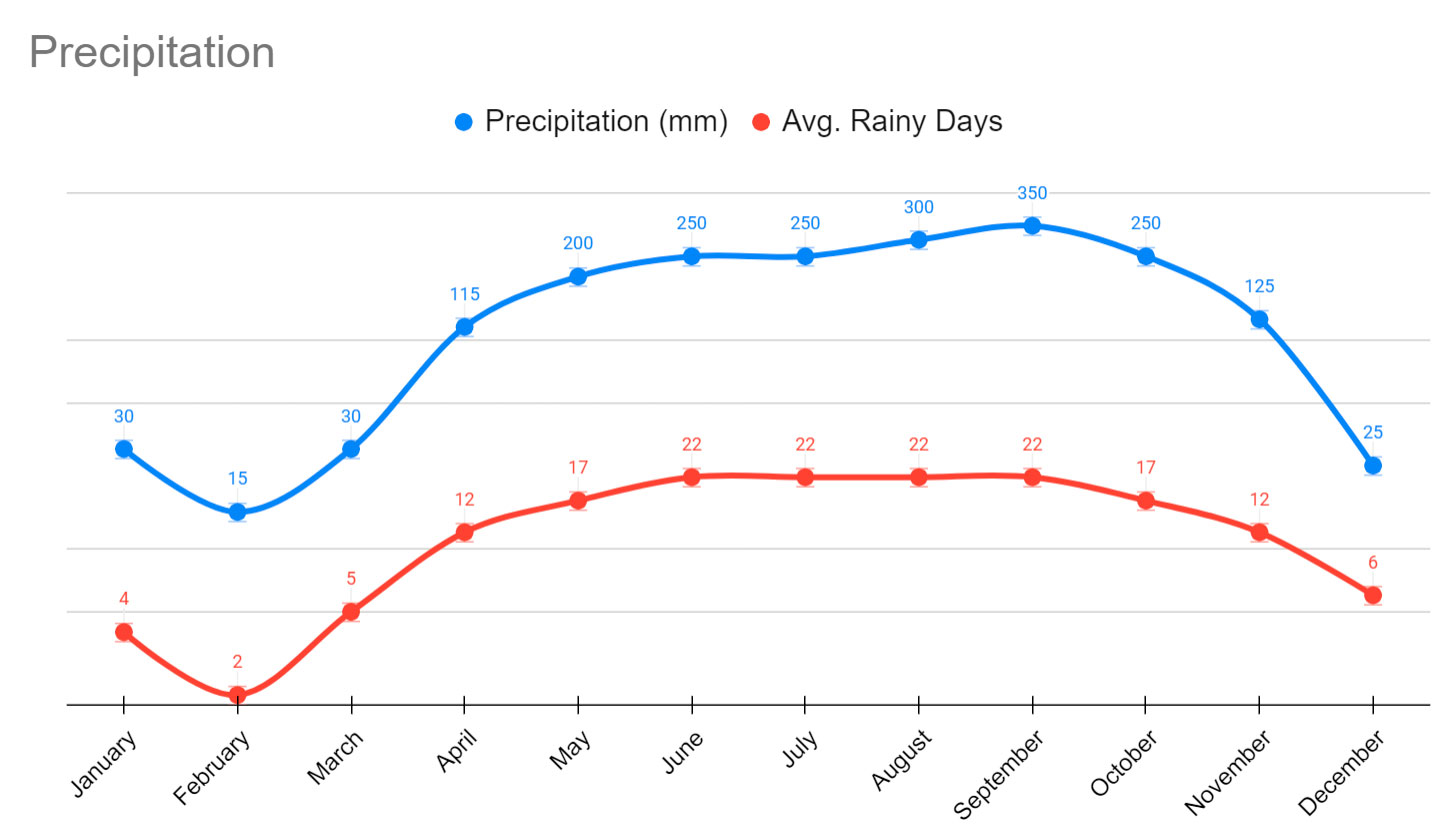
The rainy season in Ban Rak Thai lasts from May to October. Yes, we’re not wrong – it continues for six months. The rainiest months are June, July, August and September. During these months, it rains almost every day.
Smog Season

We advise avoiding travel between March and April, as it is common for farmers to burn straw from the rice harvest, and the sky is thick with smoke. Nevertheless, air pollution varies from year to year. For example, in 2022, there was only about a week of smoke, whereas in previous years, the smoke started in early February and didn’t end until early May.
Weather Forecast
Quick Facts About Ban Rak Thai
Location: Nestled in the mountains of Mae Hong Son Province, near the Thai-Myanmar border.
History: Founded by Kuomintang soldiers from China in the late 1940s. It was originally known as Mae Aw.
Culture: The village reflects a blend of Thai and Chinese Yunnanese cultures, evident in its architecture, language, and customs.
Population: Primarily inhabited by descendants of the original Kuomintang settlers.
Language: Locals speak a mix of Thai, Yunnanese Chinese, and local hill tribe languages.
Architecture: Characterized by traditional Chinese-style houses, many of which are built on stilts and feature intricate wooden carvings.
Economy: Primarily based on tea cultivation, with several tea plantations in and around the village. Oolong tea is a local specialty.
Cuisine: Offers a unique fusion of Thai and Chinese dishes, with an emphasis on fresh, locally grown ingredients.
Tourism: Known for its serene atmosphere, picturesque scenery, and cultural richness. Popular activities include tea tasting, village walks, and exploring nearby tea plantations.
Climate: Generally cooler than much of Thailand, especially during the winter months, due to its high elevation.
Accessibility: Reachable by road, with the closest major city being Mae Hong Son, approximately 44 kilometers away.
Festivals: Hosts several cultural festivals throughout the year, celebrating both Thai and Chinese traditions.
Natural Beauty: Surrounded by rolling hills, lush forests, and pristine lakes, offering ample opportunities for photography and nature walks.
Accommodation: Features a range of guesthouses and homestays, providing an immersive cultural experience for visitors.
Conservation Efforts: Engages in sustainable tourism practices to preserve its natural and cultural heritage.
Tips for Traveler to Ban Rak Thai
- Best Time to Visit: Plan your trip between November and February. During these months, the weather is cool and pleasant, making it ideal for exploring the outdoors. Also, the morning mist over the hills creates a magical ambiance.
- Transportation: Renting a scooter or a car from Mae Hong Son is a popular option. The roads are scenic, winding through the mountains, but they require careful navigation. If you’re not confident driving in such conditions, consider hiring a local driver.
- Cultural Sensitivity: Respect the local culture by dressing modestly and being mindful of your behavior. The village has a unique heritage, and showing respect will endear you to the locals.
- Language Barrier: While some villagers speak basic English, carrying a phrasebook or a translation app can help bridge the language gap, especially when interacting in more remote areas or with older residents.
- Local Cuisine: Don’t miss out on trying Yunnanese dishes like Yunnanese noodles or the local Oolong tea. The tea tasting experience here is unique, with several small tea shops offering a variety of brews.
- Accommodation: Book your stay in advance, especially during peak seasons. Options range from basic homestays to more comfortable guesthouses. Staying in a local homestay can offer a more authentic experience.
- Cash Transactions: Many establishments in Ban Rak Thai do not accept credit cards. Ensure you have enough cash for your expenses. The nearest ATMs are in Mae Hong Son.
- Hiking and Exploration: Wear comfortable shoes suitable for walking or hiking. The village and its surroundings offer beautiful trails. However, always stay on marked paths and respect private property.
- Photography: The village is incredibly photogenic. However, always ask for permission before taking photos of locals or their homes. Some may be shy or prefer not to be photographed.
- Shopping: The village markets offer unique local crafts and products, particularly tea. These make for great souvenirs or gifts. Remember to bargain respectfully.
- Health Precautions: Bring basic first-aid supplies and any necessary medications. The nearest hospital is in Mae Hong Son, which is a fair distance away.
- Responsible Tourism: Leave no trace behind. Dispose of your waste properly and minimize your environmental impact to help preserve the village’s natural beauty.
- Local Festivals: If your visit coincides with local festivals, do participate. It’s a great way to experience local customs and festivities. Check the local calendar for any events during your stay.
- Nightlife: Ban Rak Thai is not known for its nightlife. It’s a place for tranquility and relaxation. Enjoy the quiet evenings and the starry skies.
- Emergency Contacts: Keep a list of emergency contacts, including local police and medical facilities, for safety.
Pros & Cons for Travel to Ban Rak Thai
Pros
- Unique Cultural Blend: The mix of Thai and Chinese Yunnanese cultures offers a distinctive experience not commonly found in other parts of Thailand.
- Scenic Beauty: The village is surrounded by stunning landscapes, including lush tea plantations and tranquil lakes, perfect for nature lovers and photographers.
- Tranquility: Its remote location ensures a peaceful getaway, far from the hustle and bustle of city life.
- Authentic Culinary Experiences: The local cuisine, a fusion of Thai and Chinese influences, is both unique and delicious, providing an authentic taste of the region.
- Rich History: The village’s history, tied to the Kuomintang soldiers, adds depth to the travel experience through its historical narratives and architecture.
- Eco-Friendly and Sustainable Tourism: The emphasis on sustainability and eco-tourism helps preserve the area’s natural and cultural heritage.
- Opportunities for Local Interaction: Staying in homestays and engaging with the friendly locals can be enriching and offers a glimpse into their daily lives.
Cons
- Accessibility: The remote location means a longer journey to reach the village, which might be challenging for some travelers.
- Limited Amenities: Being a small, remote village, Ban Rak Thai lacks the extensive amenities and luxuries found in more developed tourist destinations.
- Language Barrier: Limited English is spoken here, which could pose communication challenges for travelers who don’t speak Thai or Mandarin.
- Basic Accommodations: Accommodation options are more rustic and basic, which might not appeal to those seeking luxury.
- Cash-Based Economy: The reliance on cash transactions could be inconvenient for travelers used to digital payments.
- Limited Healthcare Facilities: The closest advanced medical facilities are in Mae Hong Son, which is a considerable distance away.
- Seasonal Weather Constraints: Travel during the rainy season can be difficult due to muddy roads and limited outdoor activities.
Our Summary
Ban Rak Thai, a serene village in northern Thailand, offers a unique blend of Thai and Chinese Yunnanese cultures, set against a backdrop of stunning natural beauty. While it provides an enriching experience through its tranquil environment, authentic cuisine, and rich history, travelers should be aware of certain challenges. The village’s remote location contributes to its peaceful atmosphere but also means limited amenities and more challenging accessibility. Accommodations are rustic and basic, appealing to those seeking an authentic experience rather than luxury. The area operates primarily on cash transactions and has limited healthcare facilities, with the nearest advanced medical care in Mae Hong Son. Despite these drawbacks, Ban Rak Thai’s emphasis on eco-friendly tourism, opportunities for local interaction, and its unique cultural blend make it an attractive destination for travelers seeking an off-the-beaten-path experience and cultural immersion in a tranquil, natural setting.
FAQ
Ban Rak Thai is located in northern Thailand. More specifically, the village is located in the sub-district of Mok Cham Pae, Mueang Mae Hong Son District, Mae Hong Son Province.
The distance from Mae Hong Son town to Ban Rak Thai village is only about 40 kilometers, but nevertheless, because of the winding roads and the inability to accelerate on the road, you will spend about 2 hours of your time on this journey.
The drive from Chiang Mai takes about 4.5-5 hours
As this village has a Chinese cultural background and lifestyle, we recommend that you pay attention to the local souvenirs such as various types of tea (green, oolong, jasmine), dried fruits, candied fruits, and tea sets imported from China and Taiwan.
The easiest way to do this is by private transport, renting a motorcycle or car. The travel time is just over four hours. Alternatively, you can take a public bus №612 (read the details above), but then you will miss many of the sights on the way that you could see traveling in a private vehicle.
If you want to hire a private driver, though, there’s no point hiring one to visit just Ban Rak Thai. After all, you will meet a lot of interesting sights on the way, so the trip may take you several days. As we mentioned before if you want to visit Ban Rak Thai you can also take the Mae Hong Son Loop which takes 4-5 days.
The rainy season in Ban Rak Thai typically runs from May to October.
Smog season in Ban Rak Thai typically runs from February to April.
The hottest time of year in Ban Rak Thai is typically from March to May.
The best time to visit Ban Rak Thai is typically from November to February, when the weather is generally cooler and drier.
Discover the beauty and culture of Northern Thailand with our detailed travel guides. Highlighting the top scenic routes and local attractions, our guides ensure you experience the best the region has to offer. Begin your journey by visiting our bike rental in Chiang Mai. Don’t forget to review our terms and conditions for a seamless experience. With these resources, you can explore charming villages and scenic mountain trails with confidence.
Our travel advice sections provide essential tips on staying safe and enjoying your journey to the fullest. Learn about the best times to visit major attractions, participate in cultural events, and get recommendations on the best local cuisine. These insights will make your trip richer and more enjoyable. Let us help you uncover the true essence of Northern Thailand, ensuring a safe and memorable adventure filled with unique experiences and stunning scenery.
- Author: Natcha Lindberg
- Updated: 15/09/2025
- No Comments




